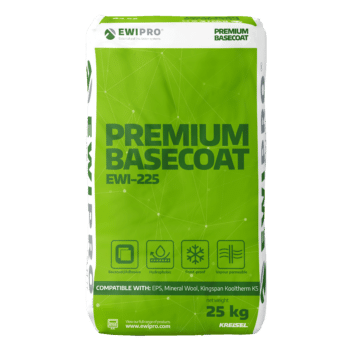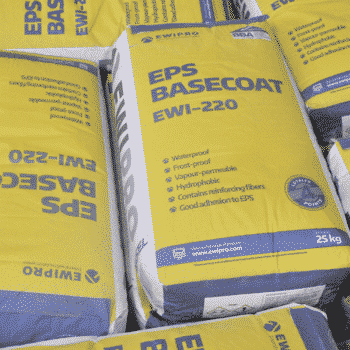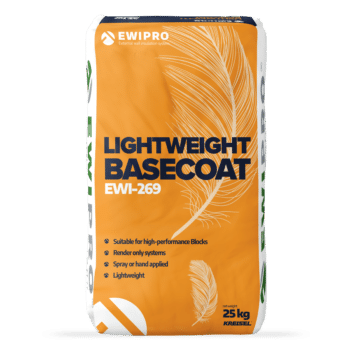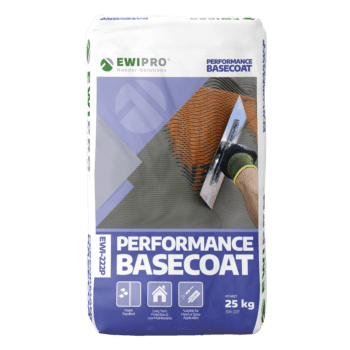4.7 out of 5 Stars on TrustPilot
How Many Coats of Basecoat Do I Need?
When rendering and painting walls, the devil is in the details. One frequently asked question in this domain is: “How many coats of basecoat do I need?” The simple answer is that it can vary depending on the material you’re using and the surface you’re working on. In this blog post, we’ll dive deeper into the world of basecoats, adhesives, and different types of renders—focusing particularly on the high-quality products supplied by the EWI Store.
What is a basecoat?
The term “basecoat” may seem straightforward at first glance, but in rendering and painting, it serves multiple critical functions that warrant closer inspection. A basecoat is a preparatory layer applied to a surface to ensure that subsequent coats, such as the finish or topcoat, adhere properly and perform optimally. However, its utility doesn’t stop at being a mere “undercoat.” Here’s a more detailed look at what a basecoat is and why it’s so important.
Physical properties
A basecoat is typically formulated to have high adhesive properties, allowing it to bond effectively with the substrate or the surface to which it is applied. Depending on its composition, a basecoat may also offer additional benefits, such as water resistance, flexibility, or increased breathability for the wall.
Compatibility
Not all basecoats are suitable for all types of surfaces or topcoats. For instance, a basecoat designed for mineral render might not be the best fit for a silicone-based topcoat. Understanding the compatibility between your basecoat and other materials is crucial for long-lasting results.
Surface Preparation
One of the primary functions of a basecoat is to even out the irregularities in the surface to which it is applied. Whether you’re working with a newly built wall or a surface that has seen better days, a basecoat can fill in minor cracks, smooth out bumps, and provide a level base for the final finish.
Adhesion and durability
Beyond surface levelling, a high-quality basecoat enhances the adhesion between the wall and the subsequent layers. This ensures that your topcoat or render doesn’t peel, flake, or suffer from other forms of premature wear and tear.
Insulation and protection
Some specialised basecoats also serve additional functions, such as providing thermal insulation or added protection against moisture ingress. EWI Store, for instance, offers basecoats formulated to work with their insulating systems, ensuring both energy efficiency and durability.
Aesthetic considerations
The colour and opacity of your basecoat can impact the final appearance of your topcoat. Light-coloured basecoats are typically preferred when using lighter topcoat shades, as they don’t alter the hue or require multiple topcoat applications to achieve the desired finish.
EWI Store basecoats and how many coats are required
The EWI Store range of basecoats is incredibly diverse; and a good thing too! Our customers’ projects vary in complexity, therefore, our range of basecoats has to be suitable. Some projects may require a lightweight wall system, whilst some require enhanced durability and the capability to attach external wall insulation boards.
EWI-225 Premium Basecoat
Our most popular and versatile basecoat. It has two major benefits that separate it from our other basecoat. Firstly, it is a dual-purpose product, which ultimately reduces wastage on-site as only one product is required. Crucially, it can also support any form of insulation board including mineral wool which is notoriously heavy. Despite this, it does not sacrifice any of its durability, flexibility, or breathability.
Coats required – One when embedding mesh directly into it. However, you can also use two thinner coats and embed the mesh with the second layer.
Adhesive coats required – A full coverage of the insulation board or the dot and dab method.
EWI-220 EPS Basecoat
As the name suggests, EWI-220 EPS Basecoat is the ideal product to act as an adhesive for EPS insulation boards. However, it is not suitable to attach heavier boards like mineral wool and phenolic foam. Despite this, it does not sacrifice any of its strength or flexibility and continues to be a dual-purpose product.
Coats required – One when embedding mesh directly into it. However, you can also use two thinner coats and embed the mesh with the second layer.
Adhesive coats required – A full coverage of the insulation board or the dot and dab method.
EWI-222p Performance Basecoat
Bridging the gap at a great price point is the EWI-222p Performance Basecoat. It performs to the same level as Premium Basecoat and is a great basecoat for render-only projects. It also meshes well with our Silicone Render range to ensure a robust and long-lasting decorative finish.
Coats required – One when embedding mesh directly into it. However, you can also use two thinner coats and embed the mesh with the second layer.
Adhesive coats required – A full coverage of the insulation board or the dot and dab method.
EWI-269 Lightweight Basecoat
EWI-269 Lightweight Basecoat is designed for both internal and external use. You can apply it to high-performance blockwork, lightweight masonry structures, and stonework. If you use a machine, you can also apply the Lightweight Basecoat up to 25mm in one pass. As it is a lighter-weight basecoat, it cannot be used for insulation purposes.
Coats required – One coat, up to a thickness of 25mm when spray machine applied.
-
Premium Basecoat (EWI-225) – 25kg
Rated 5.00 out of 5£23.23 Incl. VAT£19.36 Excl. VAT -
EPS Basecoat Adhesive (EWI-220) – 25kg
Rated 4.44 out of 5£16.16 Incl. VAT£13.47 Excl. VAT -
Lightweight Basecoat (EWI-269) – 25kg
Rated 4.00 out of 5£17.44 Incl. VAT£14.53 Excl. VAT -
Performance Basecoat (EWI-222P) – 25kg
Rated 5.00 out of 5£18.95 Incl. VAT£15.79 Excl. VAT
One Coat Dash Cover
Updating or revitalising a pebbledash exterior is commonly seen as a daunting endeavour. Applying paint to it often results in a less-than-attractive finish that deteriorates quickly. Furthermore, completely removing the pebbledash is not only a laborious and costly process but also poses a risk to the structural integrity of the building underneath.
In contrast, EWI Store’s One Coat Dash Cover (OCDC) provides a straightforward and efficient way to refresh a pebbledash surface. This specialised solution has numerous benefits that position it as the preferred choice for homeowners seeking to modernise their external walls.
Engineered to be effective with just a single layer, OCDC considerably cuts down on both time and labour expenditures linked with upgrading pebbledash. Unlike conventional approaches, this one-and-done application eliminates the need for multiple steps, thus offering a time-saving and economical alternative.
How many coats of renders and paints do you need?
You often only need a single coat of silicone render to achieve the desired finish. Silicone render offers robust coverage by design, fills in imperfections, and provides a durable, weather-resistant surface. While some specific aesthetic or structural needs may require a second coat, this is usually not the norm.
For silicone paint, you commonly apply one coat and let it dry fully before assessing the finish. To enhance the colour depth or ensure uniform coverage, especially on surfaces with varying absorption rates or pre-existing colours, a second coat is frequently necessary. However, because silicone paint generally provides superior coverage and durability, you rarely need a third coat, unless you’re targeting a very specific finish or colour intensity.
Let us know how you use basecoat and render!
Facebook
Twitter
LinkedIn
Your cart
Trade Account Login

We use cookies on our website to give you the most relevant experience by remembering your preferences and repeat visits. By clicking “Accept All”, you consent to the use of ALL the cookies. However, you may visit "Cookie Settings" to provide personalised consent.
Manage consent
Privacy Overview
This website uses cookies to improve your experience while you navigate through the website. Out of these, the cookies that are categorized as necessary are stored on your browser as they are essential for the working of basic functionalities of the website. We also use third-party cookies that help us analyze and understand how you use this website. These cookies will be stored in your browser only with your consent. You also have the option to opt-out of these cookies. But opting out of some of these cookies may affect your browsing experience.
Necessary cookies are absolutely essential for the website to function properly. These cookies ensure basic functionalities and security features of the website, anonymously.
| Cookie | Duration | Description |
|---|---|---|
| __stripe_mid | 1 year | This cookie is set by Stripe payment gateway. This cookie is used to enable payment on the website without storing any patment information on a server. |
| __stripe_sid | 30 minutes | This cookie is set by Stripe payment gateway. This cookie is used to enable payment on the website without storing any patment information on a server. |
| _GRECAPTCHA | 5 months 27 days | This cookie is set by the Google recaptcha service to identify bots to protect the website against malicious spam attacks. |
| apbct_cookies_test | session | CleanTalk sets this cookie to prevent spam on comments and forms and act as a complete anti-spam solution and firewall for the site. |
| apbct_page_hits | session | CleanTalk sets this cookie to prevent spam on comments and forms and act as a complete anti-spam solution and firewall for the site. |
| apbct_prev_referer | session | Functional cookie placed by CleanTalk Spam Protect to store referring IDs and prevent unauthorized spam from being sent from the website. |
| apbct_site_landing_ts | session | CleanTalk sets this cookie to prevent spam on comments and forms and act as a complete anti-spam solution and firewall for the site. |
| apbct_site_referer | 3 days | This cookie is placed by CleanTalk Spam Protect to prevent spam and to store the referrer page address which led the user to the website. |
| apbct_timestamp | session | CleanTalk sets this cookie to prevent spam on comments and forms and act as a complete anti-spam solution and firewall for the site. |
| apbct_urls | 3 days | This cookie is placed by CleanTalk Spam Protect to prevent spam and to store the addresses (urls) visited on the website. |
| AWSALBCORS | 7 days | This cookie is managed by Amazon Web Services and is used for load balancing. |
| cookielawinfo-checkbox-advertisement | 1 year | Set by the GDPR Cookie Consent plugin, this cookie is used to record the user consent for the cookies in the "Advertisement" category . |
| cookielawinfo-checkbox-analytics | 11 months | This cookie is set by GDPR Cookie Consent plugin. The cookie is used to store the user consent for the cookies in the category "Analytics". |
| cookielawinfo-checkbox-functional | 11 months | The cookie is set by GDPR cookie consent to record the user consent for the cookies in the category "Functional". |
| cookielawinfo-checkbox-necessary | 11 months | This cookie is set by GDPR Cookie Consent plugin. The cookies is used to store the user consent for the cookies in the category "Necessary". |
| cookielawinfo-checkbox-others | 11 months | This cookie is set by GDPR Cookie Consent plugin. The cookie is used to store the user consent for the cookies in the category "Other. |
| cookielawinfo-checkbox-performance | 11 months | This cookie is set by GDPR Cookie Consent plugin. The cookie is used to store the user consent for the cookies in the category "Performance". |
| ct_checkjs | session | CleanTalk–Used to prevent spam on our comments and forms and acts as a complete anti-spam solution and firewall for this site. |
| ct_fkp_timestamp | session | CleanTalk sets this cookie to prevent spam on the site's comments/forms, and to act as a complete anti-spam solution and firewall for the site. |
| ct_pointer_data | session | CleanTalk sets this cookie to prevent spam on the site's comments/forms, and to act as a complete anti-spam solution and firewall for the site. |
| ct_ps_timestamp | session | CleanTalk sets this cookie to prevent spam on the site's comments/forms, and to act as a complete anti-spam solution and firewall for the site. |
| ct_sfw_pass_key | 1 month | CleanTalk sets this cookie to prevent spam on comments and forms and act as a complete anti-spam solution and firewall for the site. |
| ct_timezone | session | CleanTalk–Used to prevent spam on our comments and forms and acts as a complete anti-spam solution and firewall for this site. |
| elementor | never | This cookie is used by the website's WordPress theme. It allows the website owner to implement or change the website's content in real-time. |
| viewed_cookie_policy | 11 months | The cookie is set by the GDPR Cookie Consent plugin and is used to store whether or not user has consented to the use of cookies. It does not store any personal data. |
Functional cookies help to perform certain functionalities like sharing the content of the website on social media platforms, collect feedbacks, and other third-party features.
| Cookie | Duration | Description |
|---|---|---|
| __zlcmid | 1 year | This cookie is used by Zendesk live chat and is used to store the live chat ID. |
| bcookie | 2 years | LinkedIn sets this cookie from LinkedIn share buttons and ad tags to recognize browser ID. |
| bscookie | 2 years | LinkedIn sets this cookie to store performed actions on the website. |
| lang | session | LinkedIn sets this cookie to remember a user's language setting. |
| lidc | 1 day | LinkedIn sets the lidc cookie to facilitate data center selection. |
| UserMatchHistory | 1 month | LinkedIn sets this cookie for LinkedIn Ads ID syncing. |
Performance cookies are used to understand and analyze the key performance indexes of the website which helps in delivering a better user experience for the visitors.
| Cookie | Duration | Description |
|---|---|---|
| __utma | 2 years | This cookie is set by Google Analytics and is used to distinguish users and sessions. The cookie is created when the JavaScript library executes and there are no existing __utma cookies. The cookie is updated every time data is sent to Google Analytics. |
| __utmb | 30 minutes | Google Analytics sets this cookie, to determine new sessions/visits. __utmb cookie is created when the JavaScript library executes and there are no existing __utma cookies. It is updated every time data is sent to Google Analytics. |
| __utmc | session | The cookie is set by Google Analytics and is deleted when the user closes the browser. It is used to enable interoperability with urchin.js, which is an older version of Google Analytics and is used in conjunction with the __utmb cookie to determine new sessions/visits. |
| __utmt | 10 minutes | Google Analytics sets this cookie to inhibit request rate. |
| __utmv | 2 years | The __utmv cookie is set on the user's device, to enable Google Analytics to classify the visitor. |
| __utmz | 6 months | Google Analytics sets this cookie to store the traffic source or campaign by which the visitor reached the site. |
| sib_cuid | 6 months | Purechat uses this cookie to send data to purechat.com, to connect visitors to the reservation team and track visitors to stay on portal. |
| SRM_B | 1 year 24 days | Used by Microsoft Advertising as a unique ID for visitors. |
Analytical cookies are used to understand how visitors interact with the website. These cookies help provide information on metrics the number of visitors, bounce rate, traffic source, etc.
| Cookie | Duration | Description |
|---|---|---|
| _ga | 2 years | The _ga cookie, installed by Google Analytics, calculates visitor, session and campaign data and also keeps track of site usage for the site's analytics report. The cookie stores information anonymously and assigns a randomly generated number to recognize unique visitors. |
| _gat_gtag_UA_61069204_2 | 1 minute | Set by Google to distinguish users. |
| _gat_UA-61069204-2 | 1 minute | A variation of the _gat cookie set by Google Analytics and Google Tag Manager to allow website owners to track visitor behaviour and measure site performance. The pattern element in the name contains the unique identity number of the account or website it relates to. |
| _gcl_au | 3 months | Provided by Google Tag Manager to experiment advertisement efficiency of websites using their services. |
| _gid | 1 day | Installed by Google Analytics, _gid cookie stores information on how visitors use a website, while also creating an analytics report of the website's performance. Some of the data that are collected include the number of visitors, their source, and the pages they visit anonymously. |
| _uetsid | 1 day | This cookies are used to collect analytical information about how visitors use the website. This information is used to compile report and improve site. |
| CONSENT | 2 years | YouTube sets this cookie via embedded youtube-videos and registers anonymous statistical data. |
Advertisement cookies are used to provide visitors with relevant ads and marketing campaigns. These cookies track visitors across websites and collect information to provide customized ads.
| Cookie | Duration | Description |
|---|---|---|
| _fbp | 3 months | This cookie is set by Facebook to display advertisements when either on Facebook or on a digital platform powered by Facebook advertising, after visiting the website. |
| ANONCHK | 10 minutes | The ANONCHK cookie, set by Bing, is used to store a user's session ID and also verify the clicks from ads on the Bing search engine. The cookie helps in reporting and personalization as well. |
| fr | 3 months | Facebook sets this cookie to show relevant advertisements to users by tracking user behaviour across the web, on sites that have Facebook pixel or Facebook social plugin. |
| MUID | 1 year 24 days | Bing sets this cookie to recognize unique web browsers visiting Microsoft sites. This cookie is used for advertising, site analytics, and other operations. |
| NID | 6 months | NID cookie, set by Google, is used for advertising purposes; to limit the number of times the user sees an ad, to mute unwanted ads, and to measure the effectiveness of ads. |
| test_cookie | 15 minutes | The test_cookie is set by doubleclick.net and is used to determine if the user's browser supports cookies. |
| uuid | 6 months | MediaMath sets this cookie to avoid the same ads from being shown repeatedly and for relevant advertising. |
| VISITOR_INFO1_LIVE | 5 months 27 days | A cookie set by YouTube to measure bandwidth that determines whether the user gets the new or old player interface. |
| YSC | session | YSC cookie is set by Youtube and is used to track the views of embedded videos on Youtube pages. |
| yt-remote-connected-devices | never | YouTube sets this cookie to store the video preferences of the user using embedded YouTube video. |
| yt-remote-device-id | never | YouTube sets this cookie to store the video preferences of the user using embedded YouTube video. |
| yt.innertube::nextId | never | This cookie, set by YouTube, registers a unique ID to store data on what videos from YouTube the user has seen. |
| yt.innertube::requests | never | This cookie, set by YouTube, registers a unique ID to store data on what videos from YouTube the user has seen. |
Other uncategorized cookies are those that are being analyzed and have not been classified into a category as yet.
| Cookie | Duration | Description |
|---|---|---|
| _clck | 1 year | No description |
| _clsk | 1 day | No description |
| _uetvid | 1 year 24 days | No description available. |
| AnalyticsSyncHistory | 1 month | No description |
| apbct_pixel_url | session | No description |
| apbct_visible_fields_0 | session | No description |
| apbct_visible_fields_1 | session | No description |
| apbct_visible_fields_10 | session | No description |
| apbct_visible_fields_2 | session | No description |
| apbct_visible_fields_3 | session | No description |
| apbct_visible_fields_4 | session | No description |
| apbct_visible_fields_5 | session | No description |
| apbct_visible_fields_6 | session | No description |
| apbct_visible_fields_7 | session | No description |
| apbct_visible_fields_8 | session | No description |
| apbct_visible_fields_9 | session | No description |
| ct_checked_emails | session | No description |
| ct_has_scrolled | session | No description |
| ct_mouse_moved | session | No description |
| ct_screen_info | session | No description |
| ictf_master | never | No description available. |
| li_gc | 2 years | No description |
| m | 2 years | No description available. |
| SM | session | No description available. |
| testinfinitycookie | session | No description |
| woocommerce_show_tax | 7 days | No description available. |
| wp_woocommerce_session_c5ac76b408021294cb56bcc27eddf8a1 | 2 days | No description |







2 thoughts on “How Many Coats of Basecoat Do I Need?”
What’s better, dot and dab or the full coverage?
Hi Kendall, it really depends on preference. As long as at least 40% of the board has adhesive on it, you should be safe.